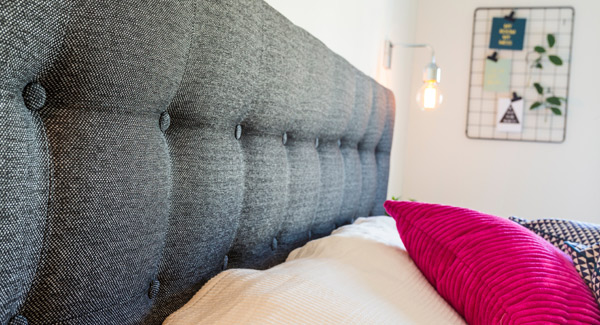Home » Headboards » Headboard Buying Guide: How To Choose A Headboard
Headboard buying guide: How to choose a headboard
Article navigation
- Published:
- Written by: Tony Brown
- Topic: Headboards
A well-chosen headboard can transform the look and feel of any bedroom. Still, with so many options available, it’s often difficult to know where to start. Here’s what you need to consider when choosing a new headboard.
Different types of headboards
Most headboards are fitted with struts that attach the headboard securely to a divan base. Strutted headboards can be easily adjusted to the desired height. In contrast, a floor-standing headboard is a full-length item that stands directly on the floor.
Headboards are available in various styles and materials to match any design aesthetic. From sleek contemporary designs to classic and elegant options, headboards can transform an ordinary bed into a stunning focal point.
Choosing a suitable material for your headboard is as important as its design. Most people primarily choose a material that compliments the style of the room. However, other factors should be considered, such as who the headboard is for.
Due to limited showroom space, some retailers may only have a small selection of headboards on display. However, they can often show you other models in catalogues, brochures, or online that you can order.
Upholstered headboards
Upholstered headboards are available in a wide range of beautiful fabrics to enhance your décor. However, there’s much more to upholstered headboards than just their visual appeal. They are ideal for individuals who like sitting up in bed for reading, watching TV, or enjoying breakfast.
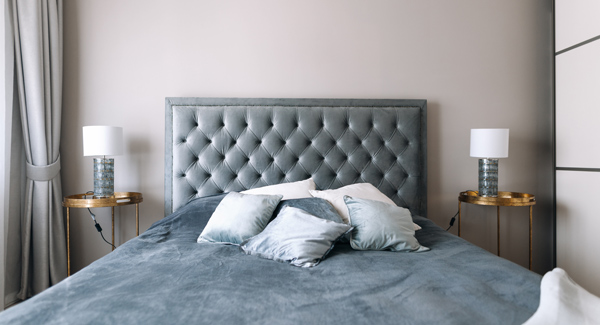
These headboards can be covered fully or partially with various soft, luxurious fabrics and occasionally with your own material. Many manufacturers also offer bed bases and headboards in matching fabrics to coordinate the look.
Though upholstered headboards are comfortable to lean against, they require special care to ensure they remain in good condition. Over time, upholstered headboards can accumulate dust and debris, potentially triggering allergies and affecting sleep quality. Therefore, regular cleaning is essential.
Certain fabrics are tougher to clean and prone to staining. So consider the headboard material carefully, especially if you eat and drink in bed.
Fabric tends to be less durable than other materials like wood or metal, and it can develop creases and pressure marks over time. Furthermore, sitting up in bed can transfer hair and body oil to the headboard, potentially leading to greasy stains that could damage the fabric’s appearance.
Upholstered headboards can also absorb odours from pets, spills, and cigarettes, resulting in an unpleasant smell. Certain fabrics may also fade, especially with exposure to sunlight.
If you sit up in bed, you may prefer a soft and comfortable material to lean against. On the other hand, if you have pets or children, you may prioritise a hard-wearing, stain-resistant material that doesn’t allow pet hair to stick against it.
Your choice of material may also depend on your budget. Headboard materials are often graded depending on their quality. You may prefer a lower-grade material if you’re on a tight budget. However, keep in mind your options will be limited. It’s also important to balance your budget against other factors like comfort, quality, and durability.
The colour of your headboard can also make a difference. While lighter tones are easy to style around and can make a bedroom feel more open and inviting, they are susceptible to marks and stains. In contrast, bold colours and elaborate patterns allow you to inject style and character into the bedroom, but can feel overwhelming.
The material your headboard is upholstered in will set the tone for your bedroom. Here’s a look at some of the more popular options.
Cotton
Cotton is a breathable material known for its softness and comfort. It is a versatile material and comes in various colours and patterns. But, cotton may wrinkle easily and is prone to staining.
Linen
Linen is a luxurious fabric with a smooth and cool texture. It is a durable fabric, which, like cotton, is breathable. However, linen wrinkles and stains relatively easily, requiring more effort to maintain.
Velvet
Velvet is a luxurious and soft fabric that brings a touch of elegance to any bedroom. It has a rich texture and can be made from synthetic or natural fibres.
While velvet is durable, it can be prone to crushing and flattening over time. Visible indentations and impressions may form over time from leaning against the headboard, affecting its appearance and comfort.
Velvet also requires regular maintenance to ensure it remains in good condition.
Chenille
Chenille is a woven fabric that has a soft texture. It’s a thick and durable material that can be made from several different fibres, such as cotton, wool, silk, and rayon.
Despite its durability, chenille can stretch or shrink and easily absorb liquids. So, it’s essential to clean up spillages promptly to prevent staining.
Chenille’s texture attracts and traps pet hair more easily than smoother materials. Pet hair may become embedded in the loops, making removing it difficult.
Acrylic
Acrylic is a synthetic material often seen as a more affordable alternative to wool. It’s durable and resistant to wear, fading, and wrinkling. However, acrylic can develop pilling over time. While not as breathable or luxurious as other materials, it is affordable and durable.
Polyester
Polyester is another synthetic material frequently used in headboards. It is a strong and durable material that retains its colour well and resists fading. Polyester is also renowned for its resistance to wrinkles and everyday wear and tear. However, polyester may not have the same luxurious feel as other materials like cotton and velvet.
Microfiber
Microfiber is a synthetic material with a soft, suede-like feel. The material is easy to clean, making it a popular choice for those with children and pets.
Leather
Leather is a classic material that complements any interior style. Unlike fabric headboards that may deteriorate, leather ages elegantly. Marks and blemishes are part of its distinct charm and character. Leather is exceptionally durable and easy to maintain, making it ideal for households with children or pets.
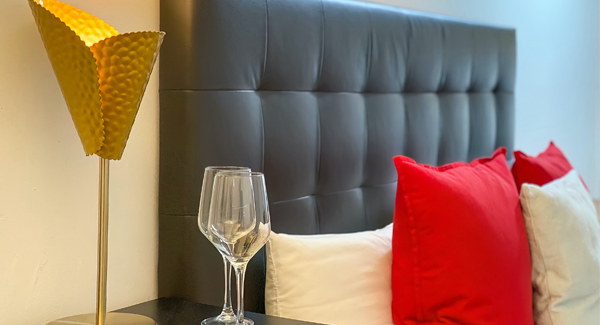
Wooden headboards
There’s nothing quite like the natural beauty and warmth of wood. Wood is renowned for its versatility and fits seamlessly into traditional or modern spaces.
Wooden headboards come in different finishes like oak, pine and beech. These headboards can often be paired with matching bedroom furniture such as bedsides, chests, and wardrobes, creating a streamlined look. Alternatively, mixing wood tones is a popular way to introduce contrast and character to the bedroom.
Unlike upholstered headboards, wooden headboards are easy to clean and maintain.
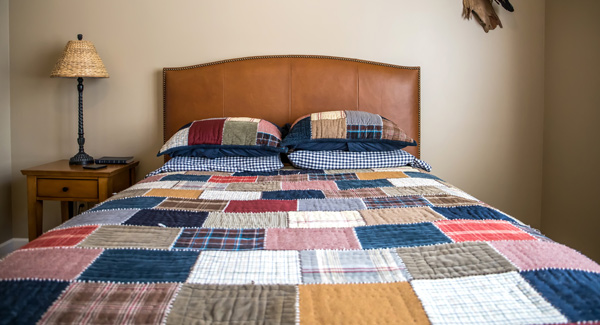
Metal headboards
Metal headboards are renowned for their elegance and versatility. From intricate floral patterns, ornate scroll works, and clean lines, metal headboards effortlessly complement traditional and modern bedroom styles.
Metal headboards come in various colourways, including black, white, gold, cream, and silver. Some metal headboards may be available with matching furniture pieces, such as bedside cabinets, to coordinate the look.
Another reason why metal headboards are popular is because they are easy to clean and require minimal upkeep.
However, unlike padded headboards, metal may feel uncomfortable to lean against. You can always prop yourself up with pillows for support, but be mindful that pillows can sometimes slip through the gaps in the headboard. Similarly, pillows could disappear behind the bed while sleeping.
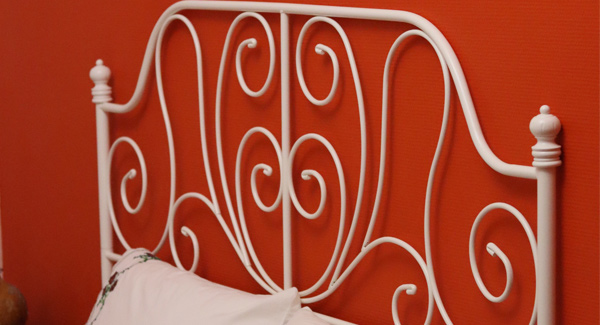
Choosing an appropriate headboard height
Opt for a headboard height that suits your lifestyle and room design. If you often sit up in bed, a taller headboard with proper back support may be more suitable.
Room size is also a crucial factor to consider. Taller headboards work well in rooms with higher ceilings, creating a stunning focal point. Yet, a tall headboard can dominate in small spaces, making the space feel cramped. Therefore, a lower headboard may be more appropriate for smaller spaces or rooms with lower ceilings.
Compatibility
When purchasing a headboard separately, ensure it is compatible with your bed. Typically, headboards are secured using bolts that pass through fixing slots and screw into the bed base.
Most headboards are designed to fit their corresponding bed size. For example, a 5’0” headboard is intended to fit a 5’0” bed. However, the pre-drilled holes might not always align perfectly. Therefore, measuring the distance between the fixing holes on the back of your bed beforehand is advisable to ensure the headboard will fit.
Standard bolts might be too short to connect the headboard to the bed in some cases, and longer bolts may be needed instead. Certain beds might come with metal brackets instead of bolts. In such cases, the headboard must also have a compatible metal bracket to ensure it can be connected to the bed. Therefore, it’s advisable to double-check with the seller that the two are compatible to avoid any issues.
Alternatively, you can opt for a freestanding headboard that doesn’t require attachment to the bed or wall.
Ordering headboard swatches
Choosing a suitable material from a swatch in the showroom can be challenging, especially as most showrooms have artificial lighting, affecting the material’s appearance.
Before you settle on a colour and material, you can often order free swatches of your preferred material. You can examine these swatches in different lights, assess their durability, and determine how well they complement your décor.
Since most headboards are usually made to order, it’s crucial to choose your fabric wisely, as returning it might not be an option after delivery.
Room space
Headboards take up additional bedroom space. Most headboards will add around two to four inches to the bed’s overall length. Some headboards may also be wider than the bed. Before deciding on a headboard, measure the area around the bed to ensure there is enough space to walk around it once the headboard is attached.
Furthermore, to avoid delivery issues, measure your property beforehand to ensure the headboard fits into the desired room. This involves measuring doorways, hallways, staircases, tight bends and ceiling heights.
Headboard delivery
If you’re buying a bed and headboard together, you may have to wait until the headboard is in stock before the bed is delivered. This can be frustrating if you have an uncomfortable bed or you’re planning for overnight guests.
Some retailers may offer a split delivery service, where they can deliver the bed and headboard separately. You may also be able to collect the headboard from the store to avoid further delivery charges and delays.
It may be possible to purchase a headboard from the display. However, these headboards are often marked or slightly damaged, so inspecting their condition before purchasing is essential.
Final thoughts
If your bedroom seems bland, a headboard can rejuvenate it. Headboards come in a vast array of designs, so take your time and choose wisely.
Share this article

About the author
Tony Brown is the founder and creator of The Bed Consultant. His career in the bed industry began in 2002. After graduating from university with a degree in Business Administration, Tony joined one of the largest independent furniture retailers in the UK as a bed consultant. Tony has helped thousands of customers find the perfect mattress.

